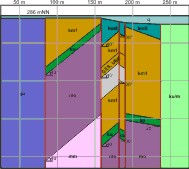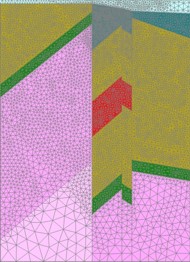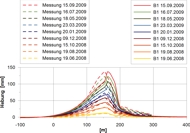 Historic city Staufen im Breisgau
Historic city Staufen im Breisgau
|
|
Project:
Analysis of time dependent uplift supposedly triggered by anhydrite swelling, Germany
Customer:
City administration Staufen im Breisgau
Cooperation partner:
Ingenieurgruppe Geotechnik GbR, Freiburg
Project description:
For extracting renewable energy from the ground to heat and cool the 16th century town hall, seven borehole heat exchangers with a length of up to 140 m were installed in the historic city center of Staufen im Breisgau. Soon after, at the end of 2007, first damage was found on several buildings in the city centre. Have of the subsoil was registered throughout an area of approximately 280 m by 180 m. In the centre of this area, about 10 mm heave per month was recorded. The maximum heave occurs in the vicinity of the ancient town hall.
Today it is believed that the heave is due to swelling Anhydrite. The swelling is caused by water influx to Anhydrite bearing formations. The inadequate injected and sealed borehole heat exchanger no. 7 is supposed to be the major cause for this influx of water.
Two-dimensional FE analyses were conducted in order to investigate the hypothesis that the measured subsoil heave could result from swelling Anhydrite as mapped by the Regional Authorities. The analyses also aim to predict possible further heave as. Furthermore an internal three-dimensional study was conducted.
Subsoil:
The subsoil in the area of the borehole heat exchangers in Staufen i.Br. consists of quaternary fills followed by the layers of the Mittleren Keuper (Schilfsandstein and Gipskeuper) and of the Unterkeuper. The Gipskeuper contains Gypsum, Anhydrite and clay minerals with swelling potential. Ground-water conditions are affected by four different ground-water storeys.
Scope of work:
- Implementation of an anisotropic elastic, perfectly plastic model with a Mohr-Coulomb failure criterion, extended by an anisotropic viscous swelling approach.
- Validation and calibration of the swelling approach based on laboratory tests.
- Back analysis of the development of heave over time in a two-dimensional cross section (plane strain).
- Prediction of possible further heave in the future.
- Study on the sensitivity of calculated results on:
- soil/rock stiffness
- soil/rock shear strength
- assumed swelling parameters
- earth pressure coefficient at rest
- ground water conditions
Used Finite Element Code:
PLAXIS 2D V9.02
Used constitutive laws:
Anisotropic elastic, perfectly plastic model with anisotropic viscous swelling approach
Typical domain size:
500 m x 211 m
20,670 triangular elements with quadratic interpolation
43,453 nodes






